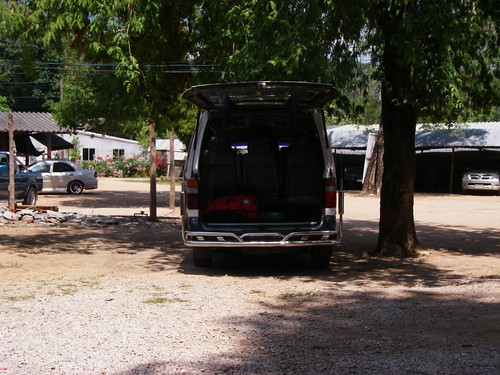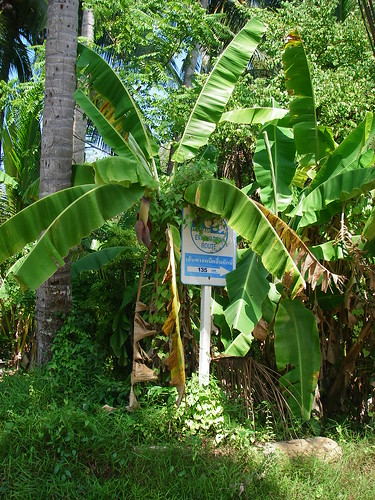Ko Libong: Future Research?
All good things come to an end, but there was no hair-rising scooter ride up-and-down slippery slopes at the end of my stay on Libong. Instead I split a longtail directly from the Nature Resort to Had Yao with the nice Swedish family who had enabled me to see the dugongs.
On the pier, I turned my back to the cool shade offered by its sister resort and faced the village square which was dozing in the mid-day sun. The minivan was already waiting. There was only one direction to go from here: back to Trang.
The van would leave when it was full. For now my backpack sat forlornly in the boot, while I sat in the shade on the terrace of a private residence, watching two children—a naked toddler and a little girl—squeal and run around, occasionally helped along by a friendly slap from an adult.
Village life at its most relaxed.
From the hammock behind me, the old man who had offered me the seat lobbed stones at the toddler’s battered plastic tractor, hitting it with great accuracy. An occasional scooter or pickup drove past, but half an hour later all was quiet. Apparently nobody was up for going on a shopping trip to Trang.
A refreshing breeze picked up. Two Brahimi kites circled high above the small hill at the back of the village, bringing back memories of other journeys.
Ko Libong lay behind me, separated by a three kilometre stretch of water, looking close enough to swim across. Just a mile or so to my left, closer to the island, we had seen dugongs yesterday. And I may not have seen the last of them.
*
“If you are serious about the dugongs, I’m even more serious,” the Professor said. “If you want to get involved in research, we could arrange something for your long stay. They’re dying by the month, you know…”
I glanced down at my notes. The survey report I had seen at the resort was all that I knew about the Libong dugongs. I didn’t know that the surveys were a regular fixture, that research on the population had been carried out since the mid-nineties. And I was making plans.
What could a volunteer do? It is hard to study dugongs from a boat or kayak. It might be useful to bring along a GPS phone and jot down some notes, but I wouldn’t get a count that way. You’d need aerial surveys. Maybe I could obtain a microlight licence.
Standardised transect surveys carried out under the same conditions would be best, as they allow for direct comparison of data. I wished I could see the raw data, and the previous surveys mentioned in the report. I was wondering about the animals’ distribution—had their range changed over the years? Had anyone tried acoustic methods? (Yes, they have.)
“I am serious,” I said. “I’ll get back to you.”
*
Just after half past twelve the old man ambled over to the van and switched on the engine. Moments later we were on actual tarmac. Every seventy-five metres there were tsunami evacuation signs by the roadside. I had seen the same signs on Libong, but the scale was different here, measured in kilometres.
Apparently, he rocky outcrops in front of the island had helped to break the fatal waves which came rolling in on Dec. 26th 2004.
“Some people think the rocks are ugly and that they should be bulldozed to make room for a nicer beach.” Looking out onto the mud exposed by the low tide, the Professor sounded wistful “I’m not sure… I think those rocks have their own beauty. Even the mud. I think it helps to clean up the water. That’s the beauty of nature.”
And he is right. The mud whispers and clicks with life; a haven for crustaceans, worms and shellfish, offering up a banquet for visiting shore birds. Gobies flit from view in the shallow pools. There is a smell, but it is fecund, alive, telling of the great feast that takes place underneath.
Libong is the crab capital of the world.
Tags: Dugongs, SE Asia, Travel, Tag Index

